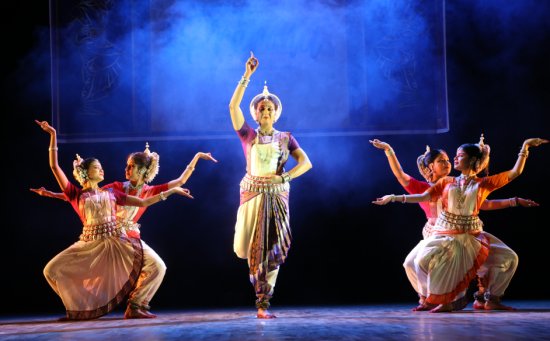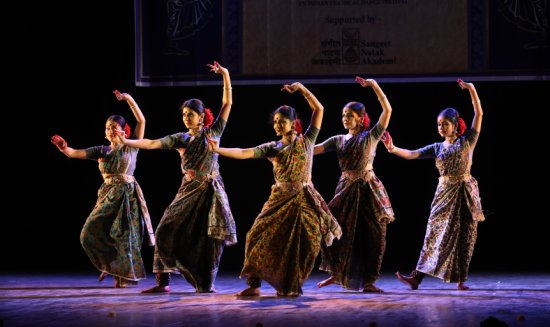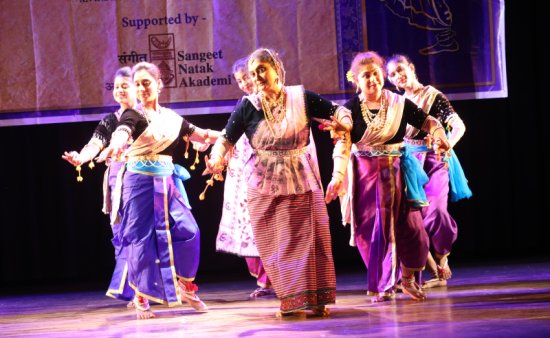
|   |

|   |
Prerona 2022 - Tapati Chowdhurie e-mail: tapatichow@yahoo.co.in August 5, 2022 Malashree, an institution of repute in cultural pursuits, presented Prerona, a three day festival of classical dance from 19th to 21st June in different venues of Kolkata. Malashree was conceptualized by Odissi dancer Dr. Arpita Venkatesh and Kathaka Sampita Chatterjee. Focus of Malashree's activities centre around imparting thorough training in Odissi and Kathak. Prerona, a yearly event, marked its 5th anniversary this year with the support of Central Sangeet Natak Akademi.  Arpita Venkatesh & group The first day's program venue was Rabindra Sadan. The program very significantly commenced with Adi Shankaracharya's Gururastakam in pure Odissi style by the students of Arpita Venkatesh. The guru who dispels darkness was venerated, his qualities highlighted. According to the Advayataraka Upanishad, the guru is more than someone who teaches specific type of knowledge, and includes in its scope someone who is also a counselor; he is one who helps mould values (Yamas and Niyamas) and experiential knowledge as much as specific knowledge, an inspirational source who reveals the meaning of life. A difficult concept translated flawlessly into Odissi dance. The message passed on was: the mind should be full of devotion to fulfill life's goal by submitting oneself to the lotus feet of the guru. Ragamalika and Talamalika of the choicest raags and taalas brought out its beauty. It was a composition of Sukhomoy Bhattacharya, vocalized by Dinesh Pal, while mardala vadan was by Kishore Ghosh and dance composition by Arpita Venkatesh. Participants Piyali Sengupta, Maumita Dutta, Indrajit Sarkar, Rajarshi Chakraborty, Manjima Sarkar, Nandita Roy, Anwesha Sarkar, Vandita Venkatesh and Arpita Venkatesh herself maintained the bhakti sthayee bhava all through. Sujata Mohapatra along with her troupe Gurukeerti gave a scintillating performance. Sujata along with her repertory members Soumya Bose, Trilochan Sahoo, Dusmant Kumar Swain, Prasanti Jena and Ankita Sengupta performed "Sritakamala" dedicating their recital at the lotus feet of Sri Krishna. Right at the start they infused an aura of auspiciousness. The dancers genuflected to the Lord of the world seeking his blessings. Jayadeva's descriptions of Sri Krishna's appearance, virtues, deeds and glory received the Lord's non-verbal and auspicious benediction. They sang victory to Srihari who adorns earrings and Tulasi garlands and who is delightful in the embrace of goddess Lakshmi. They praised Sri Krishna, the vanquisher of venomous serpent Kalia. Krishna glorified the Yadu clan. He made them delight like the Sun delights the lotus. The description of Krishna's miraculous deeds was hailed. The dance was based on raga Bhairavi, tala triputa. Hamswadhani Pallavi followed next in the rendition of pure dance. The dance began with slow, delicate movements of the neck and eyes and gradually blossomed forth into intricate melodic and rhythmic variations finally to reach a crescendo. The dance was choreographed imaginatively by Sujata Mohapatra, "Kede chhanda janila sahi" written by the famous Oriya poet Banamali Das, depicting Balyalila of Krishna born as a mortal some of whose acts were godlike - like the killing of Putana, Bakasura and subjugating serpent Kalia. It was a classic creation by the legendary duo Guru Kelucharan Mohapatra and Pt Bhubaneswar Mishra in raag Kafi and rupak taal. Shivaom was presented by Sonarpur Nadam. The dancers tried to find Shiva's dance within themselves, using their body line to create moving sculptures in space with the resonance of sound (Nad) through ghungroo to immerse into the dance. Dancers Mondira Pal, Banasree Nandi, Samali Roy, Subhradeep Shaw, Priyadarshini Sanyal, Arindam Dalui, Chinmoy Shikdar, Suchandra Karmakar could perhaps have worn better costumes. The music composition of Rajeeb Chakraborty was choreographed by Sandip Mallick. Odissi and Kathak were followed by Manipuri dance by Manipuri Nartanalaya who presented Purna Purushottam. The mythology of Vishnu was aesthetically choreographed into dance by Bimbavati Devi. It is said that whenever the world is overpowered by evil, Vishnu takes birth to redeem it. Bhakta Prahlad thus was repeatedly saved, whether from smoldering blazes of demoness Holika or from the assault of his villainous father Hiranyakashipu. Purna Purushottam was a celebration of Vishnu in the form of Narasimha. Music by R.K. Upendro Singh, N. Romila Devi and Bimbavati Devi and performers Arpita Saha, Kankana Singh, Ivana Sarkar, Mousam Nandi, Kaushik Roy and Bimbavati Devi enthralled the audience.  Moumita Chatterjee & group Udok Performing Arts of Rajib Saha presented a Tattva based on the concept of panchavoota in Bharatanatyam. Choreographed by Rajib and Moumita to music arrangement by Shankar Narayanswami, dancers Soumita Sen, Prapti Adhikary, Pubali Saha, Aisyarika Mitra, Moumita Chatterjee brought out the theme and its meaning. The production depicted the interrelation between the rhythm and the group of five elements – Prithvi, Apas, Agni, Vayu and Akasha-which are the basis of all cosmic creation and music, dance and rhythm also naturally fall under it. Well woven jathis and chollus portrayed the beauty of each element. The idea behind the costumes has come from nature itself. Hand woven Kalamkari sarees with the muted colours of nature were chosen. Red bindis symbolized concentration and the power of human mind and the presence of the five elements inside the human body. The piece was brief and aesthetically pleasing. Natyanova Performing Arts Centre of Priyadarshini Ghosh and Mohana Iyer presented a Shivastuti written by Kartika Thirunal set to ragam Bageshree. The Thillana composition of Maharaja Swati Thirunal in ragam Dhanashree set to adi talam was a delightful watch. Priyadarshini Ghosh, Sreemoyee Ghosh, Sreeradha Ghosh, Sampurna Mukherjee, Saheli Sengupta, Babita Nair, Sanjana Ghosh, Priyasmita Ghosh, Debanjali Bandhopadhyay presented authentic Mohiniattam items to the rasikas of Kolkata. Nrityangan Kathak Kendra of Paramita Maitra presented the song Thunga Thunga, written and composed by Pt. Birju Maharaj. It praised Lord Krishna, the embodiment of eternal elegance, who had enchanted the Gopis of Brindavan and engrossed them in his divine play. The vandana offered a vivid description of how the Gopis, allured by the gleaming twinkle of his eyes, the mischievous smile on his lips, and the irresistible tune of his flute were spiritually attracted to the lord. A Darbari Tarana originally composed by Pt Birju Maharaj based on Jhap taal choreographed by Paramita Maitra concluded their short recital. Performers Kanika Tarafder, Satabdi Maji, Anushree Paul, Ritushree Das, Pallika Lahiri, Bhramori Roy, Somdatta Chakrabarty, Antik Kumar Dewanji and Nilam Raj Roy performed brilliantly. Artistic Director of Darpani, Arnab Bandyopadhyay, presented the ashtapadi Dasavatar from Jayadeva's Geeta Govinda with his repertory members. The ten avatars of Vishnu were shown in the vocabulary of Odissi. The scope of making the piece spectacular is manifold. Its proper utilization was remarkable. Anusmita Bhattacharya, Anaya Ghosh, Nikita Das, Deyasini Guha, Mousumi Samanta, Soham Dey, Avijit Das, and Arnab Bandyopadhyay danced to satisfaction. Their use of stage space was remarkable. The dancers were in top form.  Poushali Chatterjee & group At ICCR on June 20, 2022, Ram Stuti was presented solo by Rajib Bhattacharjee. Artistic Director Poushali Chatterjee of Nandanik Movement Arts performed Sarasa Vasante on the famous ashtapadi Lalita Lavangalata from Geeta Govinda. The poetry describes the outpouring of rasa through the flowering vegetation, cooing of the cuckoo, humming of the bees and the young maidens dancing in abandon with Lord Krishna. Radha is away from Krishna and her Sakhi describes these scenes of Vasanta which evokes shringar rasa in her. The choreography highlighted the contrast between Radha's sadness at being away from Krishna and the passionate exuberance of spring, through a contrast of vilambit and drut laya, the power and the soft beauty of the Manipuri dance vocabulary translated the piece into the eternal language of love. Set on taal Tanchep of 4 beats and Menkup of 3 beats, the composition used different rhythm patterns to suit spring season. Music and dance concept and choreography by Poushali Chatterjee, rhythm arrangement and Pung were by R.K. Upendro Singh and vocalist N. Romila Devi, music composer Debasish Ghosh gave fitting support. Performers Poushali Chatterjee, Malabi Choudhury, Sharmila Das, Ankita Ghorai, Anindita Mondal and Rupsha Roy created aesthetic bliss. Narteshwar Cultural Centre of Odissi exponent Pushpita Mukherjee's repertory members' Bhangi Tarang presentation was a combination of Sthayi Nritya and Botu Nritya. Sthayi nritta showcased different patterns of movements in a particular syllable of taal used in vocal music. Botu Nritta is also a Sthayi Nritya where dancers focused on various sculptural postures seen in various temples in Orissa. Dance was directed by Puspita Mukherjee and performed by Kamalika Bose, Nibedita Das, Sukarna Mazumder, Tanusree Sengupta, Trisha Makhal, Saimontik Das, Deblina Biswas, Debjani Roy and Samrat Sastri. Kalamandalam Venkitt regaled the audience with his beautiful abhinaya on forest and wildlife. His co-artiste KK Gopakumar (chenda) was very supportive. The expressive power of Kathakali which has been mastered by Venkitt reigned supreme. The flora and fauna of the forest in the hands of the Kathakali dancer came alive. Garden Reach Nikkon Odissi Nritya Bitan of Kishnendu Roy presented Shakti. Madhuri Majumdar's Bhama Kalapam set to Bhairavi and talam mishra chapu on the legendary Satyabhama was performed in the style of Guru Vempati Chinna Satyam whose disciple she was. Ashimbandhu Bhattacharya and Upasana Center of Dance's Taalchakra Parikrama was about Taal being the sanctum of the golden womb from where dancers have found their being. Taal being their obvious destiny and destination too is a cycle - a chakra - in itself. Taal holds the whole wide universe in its rhythmic embrace. From the mighty solar tread of the ever burning Sun to the mutest murmur of the human heart, all rhyme to this all pervasive rhythm. The concept, brainchild of Ashimbandhu, was presented by Tonni, Avik, Subrato, Shukonya, Trisha, Anamika and Srijita in all its glory. This merged seamlessly into Bhakti Rasa Parikrama where the choreographer went solo. The subtlety of expression of Kathak had its own beauty. Kalakarma Foundation presented the mythological story of Devi and sang its praise. It was the usual story of the Devi, the wife of Shankara. Swar Tarang by Malasree explored the scope of Swar and Dhwani. It was the presentation of Sangeet which includes Geet, Vadya and Nritya. Based on raag Kirwani, taal teen taal created ripples. This interesting piece was graced by Bikash Sandhukhan on keyboard, Subir Thakur on tabla, Sandip Neogi on sitar, Abhijit Roy on sarod, and Biswajit Ghosh and Soumita on vocals. Choreographed by Sampita Chatterjee who danced with Anwesha Ghosh, Imantika Biswas, Barsha Laha, Ishika Biswas, it marked Sampita's comeback on the proscenium stage. On day three of the festival at the Jamini Roy Gallery of ICCR, lecture demonstrations were held by Kathak exponent Dr. Malabika Mitra well versed in the technical brilliance of Jaipur gharana and delicate grace of Lucknow gharana - trained by Ramgopal Mishra and Pt. Birju Maharaj - of Kathak. She spoke on padhant - the soul of Kathak. An artiste of rare individuality with a thorough knowledge of the old traditional temple art of story-telling style of Ayodhya, which she learnt under Late Pandit Om Prakash Maharaj for more than a decade. Malabika has imbibed the individual styles of Pandit Birju Maharaj, Sitara Devi and Pt Vijay Shankar. With long years of intensive training and sheer dedication, Malabika has developed a complete style of her own and is a store-house of knowledge, both theoretical and practical. Her rendition of padhant (recitation of bols) was eloquent and artistic. For Malabika Mitra, dance is the reflection of the journey of life exploring the spiritual tranquility of our inner world and the beauty around us as revealed in her lec/dem. Odissi dancer Sujata Mohapatra did a lec-dem on the 'Aesthetic aspects in Guru Kelucharan Mohapatra Gharana.' An excellent and practicing performer, who is in her peak, she showed the minute nuances of her guru's teachings. Odissi dance aspirants gaped wide eyed as they tried to imbibe the full gist of her rendition. Piyal Bhattacharya's topic 'Natya Shastra's Vritti, Pravritti and Dharmi on present form of Classical Dance' spoke of the four types of Vritti mentioned in Natya Shastra (Chapter 20-Vrittivicaradhyaya). Vritti, said Piyal, is considered to be Natyamata. Natya is of two types - Avidhhya Natya (Tandav Pradhan) and Sukumar Natya (Intellectual in subject). Piyal said that the categorization of Dasharupaka is founded upon the concept of Vritti. It has contributed to the specialization of Natya. For instance, Bhaana is Bharati Vritti where the process of the Natya is based on verbal usage. This does not at all suggest that only Bharati Vritti is employed and rest of the Vrittis are non-existent. It only states that Bharati Vritti is given more importance than other Vrittis, a matter of Pravala and Durvala in terms of Vritti. The invisible nature of Natya's entity was elaborated to show that it is to be found in the methodology prescribed by Bharata to manifest Natya in its physical existence. This methodical process is categorized into Vritti based on Verbal mode, Physical mode, Emotional mode and Aesthetic mode, he explained. All these modes when applied in the execution of abhinaya is known as Samanyabhinaya. So, here, the term generality in abhinaya actually distinguishes Bharata's system of abhinaya from other performing arts practices. Performing arts require a form or shape in order to be manifested in this physical world. This form or shape is executed by an approach. This approach in general terms is known as stylization. This mode of stylization changes according to the geographical zones, which adds its own unique characteristics to this mode. So, this adds dimensions of time and space to the process known as Vritti, says Bharata in his Natya Shastra. According to Bharata, Vritti along with the dimensions of Time and Space generate Pravritti. These Pravrittis are of four types based on geographical zones: Avanti, Dakshinatya, Panchali and Oudramagadhi. Henceforth, Bharata after prescribing the methodology or process, prescribed the category of presentation for the execution of performing arts. They are Natyadharmi and Lokadharmi. To clear any doubt, Lokadharmi do not indicate any kind of folk culture, it has a broader scope than just folk culture. Bharata in his treatise has delineated the difference between Natyadharmi and Lokadharmi which is based on the degree of stylization and intellectual expression of the subject. Natyadharmi mode of presentation uses symbols and metaphors giving an essence of the subject rather than direct portrayal. Lokadharmi mode of presentation uses more natural and uncomplicated ways to manifest the subject, mostly direct representation of the subject, which can easily be grasped by the common mass. Kalamandalam Piyal Bhattacharya has been engrossed in the research and practical reconstruction of the complete performance system of Natya, from the perspective of Natya Shastra for the past 20 years of his life. He has been awarded a grant by Sangeet Natak Akademi, New Delhi, for 'Safeguarding the intangible Cultural Heritage of India' 2014-15 for practical reconstruction of Bharata's dance and music tradition as Marga Natya, along with his 20 year journey in reconstruction of Natya Shastra as a performance system in its entirety, including its music. He trained in both instrumental and vocal music under great Gurus of the tradition. This interaction with scholars also led him to Indian philosophical studies and Vedas in the Sanskrit tradition. He has been researching relentlessly in the reconstructing evolving from the practice of Nritta, Geet and Abhinaya based on Bharata's theatrical system of performance, based on the Natya Shastra. Through this work he sincerely wishes to create a dialogue with the contemporary societal concerns, and create a bridge between the ancient and the modern. His research has been a constant search of the language of Indian theatrical traditions. A consummate artiste, Piyal Bhattacharya is also a painter, sculptor and costume designer. Proficient in Sanskrit, English, Bengali, Hindi and Malayalam, he has also trained in the martial art forms of Kalaripayettu under P.K. Balan Gurukul, and Thang Ta at Anjika, Kolkata. Understanding the past is of utmost importance to understand the present and act for the future. Dr. Arpita Venkatesh spoke at length about 'Application of Karanas of ancient times in Odissi dance.' Presently under the guidance of Sujata Mohapatra, Arpita has been taking long strides in her chosen field. She is employed with Rabindra Bharati University as a Guest Lecturer in dance. Her own production 'Satyam Jnanam Anantam' brought her a lot of critical acclaim. Dr. Puspita Mukherjee's lecture-demonstration was on Rabindra Nritya. Head of the dance department, Rabindra Bharati University with a thorough knowledge of the dance style to be pursued to match the lyrics of Rabindra Sangeet, she gave her best. However since the seminar time exceeded beyond limit and she was the last speaker, there were few takers. Through her own school Narteswar Cultural Centre, she imparts lessons in Odissi dance and Rabindra Nritya.  Tapati Chowdhurie trained under Guru Gopinath in Madras and was briefly with International Centre for Kathakali in New Delhi. Presently, she is a freelance writer on the performing arts. |